When I hit my 40s, losing weight became a big challenge. The pounds piled on, and my metabolism slowed down. I was ready for a change, but the thought of another diet was overwhelming.
Then, I found a game-changing weight loss plan. It’s helped many people in their 40s and older. This plan tackles the unique issues we face as we age. It focuses on good nutrition, exercise, and lifestyle changes for a healthier you.
Are you ready to lose belly fat, boost your metabolism, and feel great? This plan can help you achieve that. It’s time to say hello to a fitter, more vibrant you.
The path to weight loss in your 40s won’t be simple. But with the right tools and advice, you can get the results you want. Let’s explore the secrets to lasting weight loss together.
Understanding Weight Loss Challenges After 40
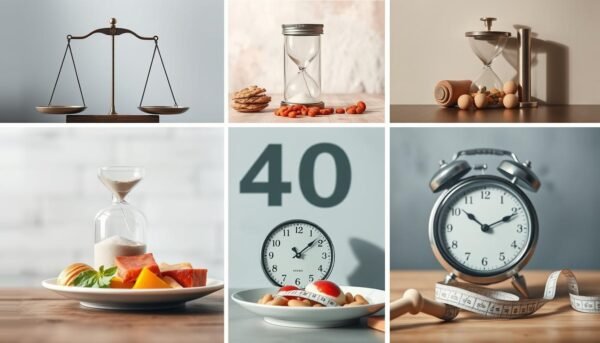
When we reach our 40s, losing weight gets harder. Hormonal changes, metabolism shifts, and lifestyle changes play big roles. Let’s explore the main hurdles in losing extra pounds after 40.
Hormonal Changes and Metabolism Shifts
Hormonal shifts, like a drop in estrogen, can cause weight gain in the 40s. This leads to more fat storage around the belly. Also, our metabolism slows down with age, making it tough to burn calories like we used to.
Impact of Lifestyle Changes
Our lifestyles change a lot as we age. We might move less and spend more time on screens. These changes hurt our ability to lose belly fat and reduce abdominal fat. With our metabolism slowing down, these changes can lead to weight gain in our 40s.
Age-Related Body Composition Changes
After 40, we lose muscle mass, known as sarcopenia. Losing muscle makes our metabolism less efficient. This makes it harder to boost our metabolism and burn calories. It can also increase belly fat and weight.
To beat these challenges in our 40s, we need a plan. This plan should include good nutrition, exercise, and lifestyle changes. By understanding these challenges, we can make a plan to reach our weight loss and fitness goals.
Essential Nutrition Principles for Weight Management
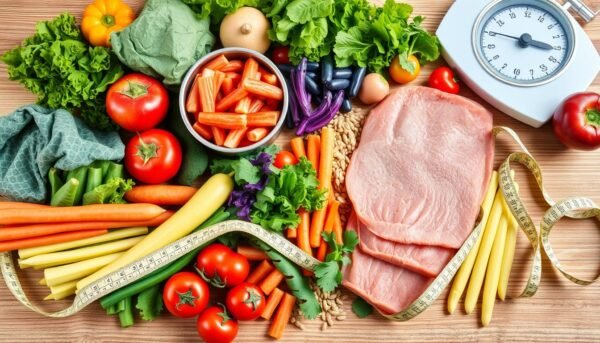
To lose weight in your 40s, eat a balanced diet. Choose whole, unprocessed foods that boost your metabolism and health. Include fruits, veggies, lean proteins, whole grains, and healthy fats.
Try to eat 20-30 grams of protein at each meal and 10-15 grams in snacks. This keeps your muscles strong, which is key for a healthy metabolism. Eat lean meats, eggs, fish, and also plant-based foods like lentils, beans, and nuts.
- Lean ground beef: 20.8g protein per 100g
- Skinless chicken breast: 23.2g protein per 100g
- Lentils: 9g protein per 100g
- Almonds: 21.2g protein per 100g
Eat foods high in fiber like oats, chickpeas, and whole grains. They make you feel full and help keep your blood sugar stable. Aim for 25-30 grams of fiber daily.
| Food | Fiber Content (per 100g) |
|---|---|
| Oats | 10.4g |
| Chickpeas | 5.9g |
| Brown rice | 3.2g |
Reduce your intake of processed foods, sugary drinks, and too much alcohol. This helps your weight loss diet and metabolism boosters. Eat whole, nutrient-rich foods to get your flat stomach tips.
Smart Protein Strategies to Boost Metabolism
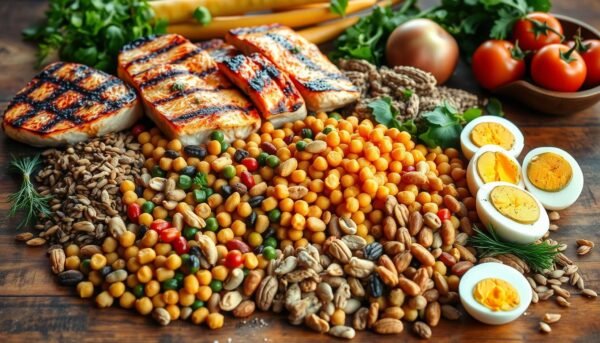
Protein is key for keeping muscle mass and a healthy metabolism, especially after 40. To get the most from protein for weight loss, try these smart tips:
Optimal Protein Portions
Go for 20-30 grams of protein at each meal and 10-15 grams at snacks. This balance helps you get enough protein without too much or too little. Adjusting your portions based on your size and activity is important.
Best Protein Sources After 40
- Lean meats like chicken, turkey, and pork
- Fish such as salmon, tuna, and tilapia
- Eggs and dairy products like Greek yogurt and cottage cheese
- Legumes, including beans, lentils, and peas
Timing Your Protein Intake
Eating protein evenly throughout the day boosts muscle protein synthesis and your metabolism boosters. Eat protein before and after workouts to help muscles recover and grow.
By focusing on the right protein amounts, quality sources, and timing, you can use this weight loss diet to help your flat stomach tips and metabolic health.
How to lose belly fat After 40: Targeted Strategies

Losing belly fat after 40 is tough, but doable with the right plan. Focus on diet and exercise that targets visceral fat. This fat builds up around your midsection and is hard to lose.
High-intensity interval training (HIIT) is a great workout choice. Try burpees, jumping jacks, and sprints to burn calories and boost your metabolism. Add strength training for your core, like planks and crunches.
Your diet matters a lot too. Cut down on added sugars to avoid belly fat. Eat more fruits, veggies, whole grains, and lean proteins. They make you feel full and are good for you.
Managing stress and getting enough sleep is also key. High cortisol levels from stress can add to belly fat. Try for 7-9 hours of sleep each night to help with weight loss.
By using these strategies, you can lose belly fat after 40. This will improve your health and make you feel better.
Remember, losing belly fat takes time and effort. Stay patient and keep working at it. With the right plan, you can reach your weight loss goals and live a healthier life.
The Role of Fiber in Weight Loss Success
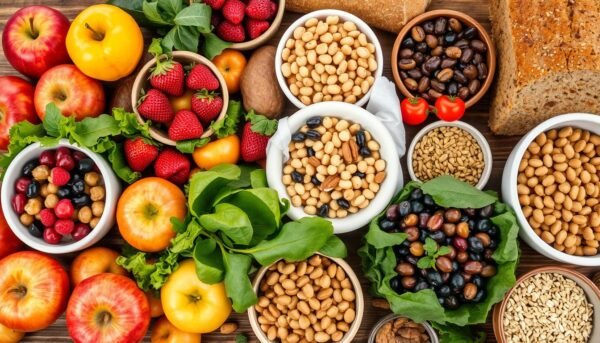
Fiber is a big help when you’re trying to lose weight. It makes you feel full and keeps your digestive system healthy. To lose weight, try to eat 25-30 grams of fiber every day. This can help you get a flatter stomach and boost your metabolism.
High-Fiber Foods to Include
It’s important to eat foods high in fiber. Good options are:
- Whole grains like barley, bulgur, and brown rice
- Fruits and vegetables, such as berries, apples, and leafy greens
- Legumes, beans, and lentils
- Nuts and seeds
Eating a variety of fiber-rich foods helps keep your diet balanced. This supports your health and weight loss goals.
Daily Fiber Requirements
The amount of fiber you need changes with age and gender. Here’s a basic guide:
- Women over 50 should aim for at least 21 grams of fiber per day
- Men over 50 should target 30 grams of fiber per day
- Younger men (up to age 50) should strive for 38 grams of fiber daily
Start slowly with more fiber to avoid stomach problems. Drink lots of water with your high-fiber foods to get the most benefits.
Strategic Meal Timing and Portion Control

For a successful weight loss diet, timing and portion control are key. Eating smaller, more frequent meals helps keep your blood sugar stable. It also helps manage hunger better. Try to have three balanced meals and 1-2 healthy snacks each day to keep your metabolism going.
Watch your plate sizes – use smaller plates to feel full with less food. Practicing mindful eating by eating slowly can help you know when you’re full. Also, try the 16:8 intermittent fasting method for waist slimming techniques.
Late-night snacking can hurt your sleep and metabolism. Try to stop eating a few hours before bed. With some planning and discipline, you can get good at flat stomach tips through smart meal timing and portion control.
- Eat 3 balanced meals and 1-2 healthy snacks per day
- Use smaller plates to visually reduce portion sizes
- Practice mindful eating to recognize when you’re full
- Consider intermittent fasting methods like 16:8
- Avoid late-night snacking for better sleep and metabolism
By using these smart meal timing and portion control strategies, you can make big strides in your weight loss diet goals. You’ll also keep a healthy, flat stomach in your 40s and beyond.
Healthy Fats and Their Impact on Weight Loss
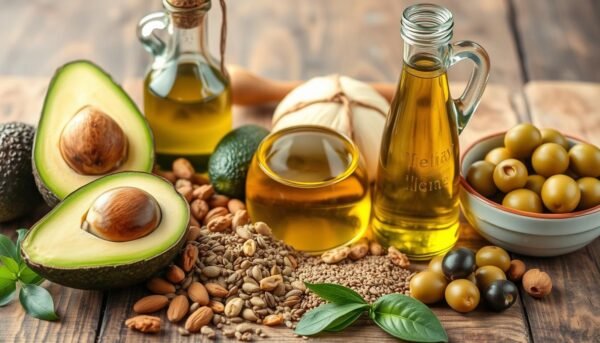
Healthy fats play a big role in weight loss, especially for people in their 40s. They help support weight loss and keep your metabolism healthy. By knowing about essential fatty acids and eating the right amounts, you can manage your weight better.
Essential Fatty Acids for Health
Unsaturated fats, like those in olive oil, avocados, nuts, and fatty fish, are important for hormone balance and health after 40. They reduce inflammation and help your body use insulin better. This is key for losing weight. Make sure to eat a variety of these metabolism boosters in your weight loss diet.
Portion Guidelines for Fats
For a 1,600-1,800 calorie diet, you should eat 53-60 grams of fat each day. This helps you get enough healthy fats without too much. Try to eat less of saturated and trans fats, as they can cause weight gain. Omega-3 fatty acids in fatty fish are good for your heart and brain, and help with weight loss.
| Fat Type | Recommended Intake |
|---|---|
| Unsaturated Fats (e.g., olive oil, avocado, nuts) | 53-60 grams per day |
| Saturated Fats (e.g., butter, red meat, full-fat dairy) | Limit to less than 10% of total daily calories |
| Trans Fats (e.g., fried foods, baked goods) | Avoid as much as possible |
Strength Training for Metabolic Health

As we get into our 40s, keeping muscle mass and boosting metabolism is key for losing weight. Strength training is vital for weight management after 40. Try to do 2-3 strength training sessions a week, focusing on all major muscle groups. These tough exercises build lean muscle and boost your metabolism, helping you burn more fat burning exercises all day.
Compound exercises like squats, deadlifts, and push-ups are great for burning calories and working many muscles at once. Increase the weight and resistance as you get stronger to keep challenging your muscles and boost metabolism boosters.
Adding regular cardio to your strength training is best for core workouts and health. A mix of resistance training and aerobic activity helps you lose weight and improve metabolic health.
| Exercise | Recommended Sets and Reps |
|---|---|
| Bear Crawl | 3 rounds of 20 to 30 seconds |
| Pushup | 3 sets of 12 to 15 reps |
| Dumbbell Thruster | 3 sets of 6 to 8 reps |
| Deadlift | 3 to 4 sets of 6 to 8 reps |
| Burpee | 3 sets of 40 seconds on, 20 seconds off |
| Cardio Row | A suggested workout utilizing power, endurance, and cardiovascular potential |
| Squat | 3 to 4 sets of 8 to 12 reps |
| Walking Lunge | 3 sets of 20 to 30 seconds |
| Assault Bike | 5 rounds of 30 seconds on, 90 seconds off |
| Kettlebell Swings | Instructions on how to perform the exercise to utilize metabolic power |
It’s smart to talk to a certified fitness pro before starting strength training. They can help you learn the right techniques and keep you safe. With the right plan, you can use resistance training to boost your fat burning exercises, metabolism boosters, and core workouts.
Sleep Optimization for Weight Management
Quality sleep is key for managing weight after 40. It helps balance hormones and regulate metabolism. This makes your weight loss efforts more effective. By focusing on sleep, you can get closer to your flat stomach goals.
Sleep Duration Guidelines
Try to sleep 7-9 hours each night for a healthy weight and metabolism. Sleeping less than 7 hours can lead to weight gain. But, enough quality sleep helps you stick to your diet and exercise plans better.
Creating a Sleep-Friendly Environment
To improve your sleep for weight management, make your bedroom sleep-friendly. Keep it cool, dark, and quiet. Have a regular sleep schedule and bedtime routine, like relaxing before bed.
Limit screen time and avoid caffeine in the afternoon. These can make it hard to fall and stay asleep.
This post may contain affiliate links which means I may receive a commission for purchases made through links. I will only recommend products that I have personally used! Learn more on my Private Policy page.